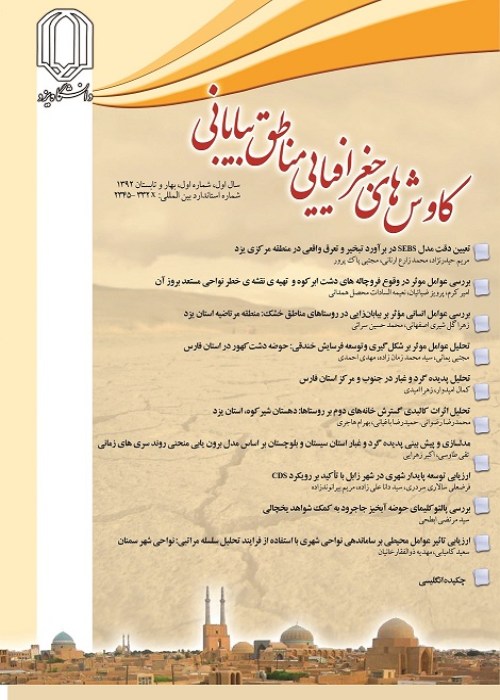Revealing the harvesting, transfer and sedimentation areas of the Lut desert world heritageIn the period from 2019 to 2020
Soil erosion is a phenomenon that is carried out by the wear and tear of soil on the surface of the earth and its transfer to another place by water or wind processes. This process has caused the emergence of many geomorphological forms and landforms in the world (Shayan and Zare, 2011). The extent of the world's reservoirs is large and these areas have active dynamics due to the instability of sands and undergo many geomorphological changes in a short period of time. There are many wind landforms of compression and erosion type in Lut desert. These geomorphological and geological phenomena are one of the most important natural attractions of the Lut plain and desert, which can be said to be rare or unique in the world. Landforms such as huge sand dunes and pyramids, which are unique in their kind in the world, have a very high ability to attract different tourists, including adventure tourists, scientific tourists, educational tourists, and other tourists (Maqsoudi et al. 2004). In this research, the Dayvis erosion cycle has been investigated in the Lut desert geoforms using differential radar interferometric techniques and the collection and deposition points have been revealed.
In order to reveal the harvesting, transportation and sedimentation areas of the Lut desert world heritage, the radar data of Sentinel 1 satellite and the digital model at a height of 30 meters have been used for software processing. The radar technology that has been provided thanks to the rapid development of space technology (Ferretti et al., 2007) has been done with the radar interferometric method (DInSAR). In this research, we also used Landsat 8 satellite images to prepare a map of the study area, ASTER satellite digital elevation model (DEM) with a resolution of 30 meters to prepare a hypsometric map and radar processing, vector layers of geoscience databases, and windfalls of synoptic stations located around the study area. It has wind direction and speed information; it is also prepared from the National Meteorological Organization. Information processing has also been done in SNAP and GIS software.
In order to reveal the harvesting, transportation and sedimentation areas of the Lut desert world heritage area, the differential radar interferometry method was used between 2019 and 2020 and the radar data of the Sentinel 1 satellite, which is of C-Band type and has the penetration of radar waves with a wavelength equal to the frequency of 405 5 GHz is used. According to the outputs, the phase difference between the two data in the Kluts has a negative trend and it is quite noticeable that it shows the erosibility of the Kluts, which is caused by the winds of the region.It should be noted that due to the resistance of Lut block to the internal forces of the earth, the effect of faults in the height changes in the bedrock of Lut block and the area of the Kluts is very small and the observed changes are only due to wind erosion. After the unwrapping process, the unwrapped layer is converted into a displacement layer and then georeferenced. The final map of the vertical displacement of Lute Kluts was drawn in a general and classified manner, which shows many changes during a year. But in general, the northern parts of Klut have more erosion resistance due to high wind speed and high erosion power. The yardangs in the northwest parts of Kluts can be a proof of this statement. Therefore, most of the area of Klots is eroding every year and these sediments have been accumulated in many parts of Rig Yalan. Middle Hamada can be considered as a transition range. In order to investigate the dominant processes in the creation of geomorphological complications in Lut, synoptic data were analyzed at Shahdad, Nehbandan and Nusratabad stations, and the gulbads of the region were drawn. According to the winds of the region, the erosion trend of the Klots from the northwest to the southeast shows a significant trend in wind erosion.
Since Lot is the most important natural work of the country that has been registered globally, investigating its geomorphological complications is also one of the research priorities. These surveys allow for accurate knowledge and information about the conditions and characteristics of the region. Among these, Kluts and Rig Yalan are the most important geomorphological phenomena of Lot, which were investigated in this research. Kluts and Rig Yalan are located in the hydro-eolian region and are always subject to significant geomorphological changes. According to the investigations carried out in this research, it was found that there is an erosion cycle in the area of Klut. Rig Yalan and Middle Hamada. In the area of Kluts, the highest amount of digging was observed in the northern and central parts. In the northern part of the Middle Hamada, which was referred to as the transfer zone, it shows the digging of sediments, but in the southern parts of this region, we have sediment accumulation. In different parts of Lut sand, which is known as the sedimentation area, the accumulation of sediments has been different, so that in the western and western parts, the height of the sand pyramids has decreased, but in the eastern and especially the northern parts. The east shows the increase in height and accumulation of sediments. According to the mentioned contents, the erosion cycle in this range is rotational and in the counterclockwise direction. Among the articles that have been worked in Lut and can be cited as a confirmation of this research, is the article Thermal cyclone of Lut, Yemen, in which he mentions the existence of a thermal cyclone in Lut and the air flow in this cyclone is opposite. The hands of the clock say.
- حق عضویت دریافتی صرف حمایت از نشریات عضو و نگهداری، تکمیل و توسعه مگیران میشود.
- پرداخت حق اشتراک و دانلود مقالات اجازه بازنشر آن در سایر رسانههای چاپی و دیجیتال را به کاربر نمیدهد.




